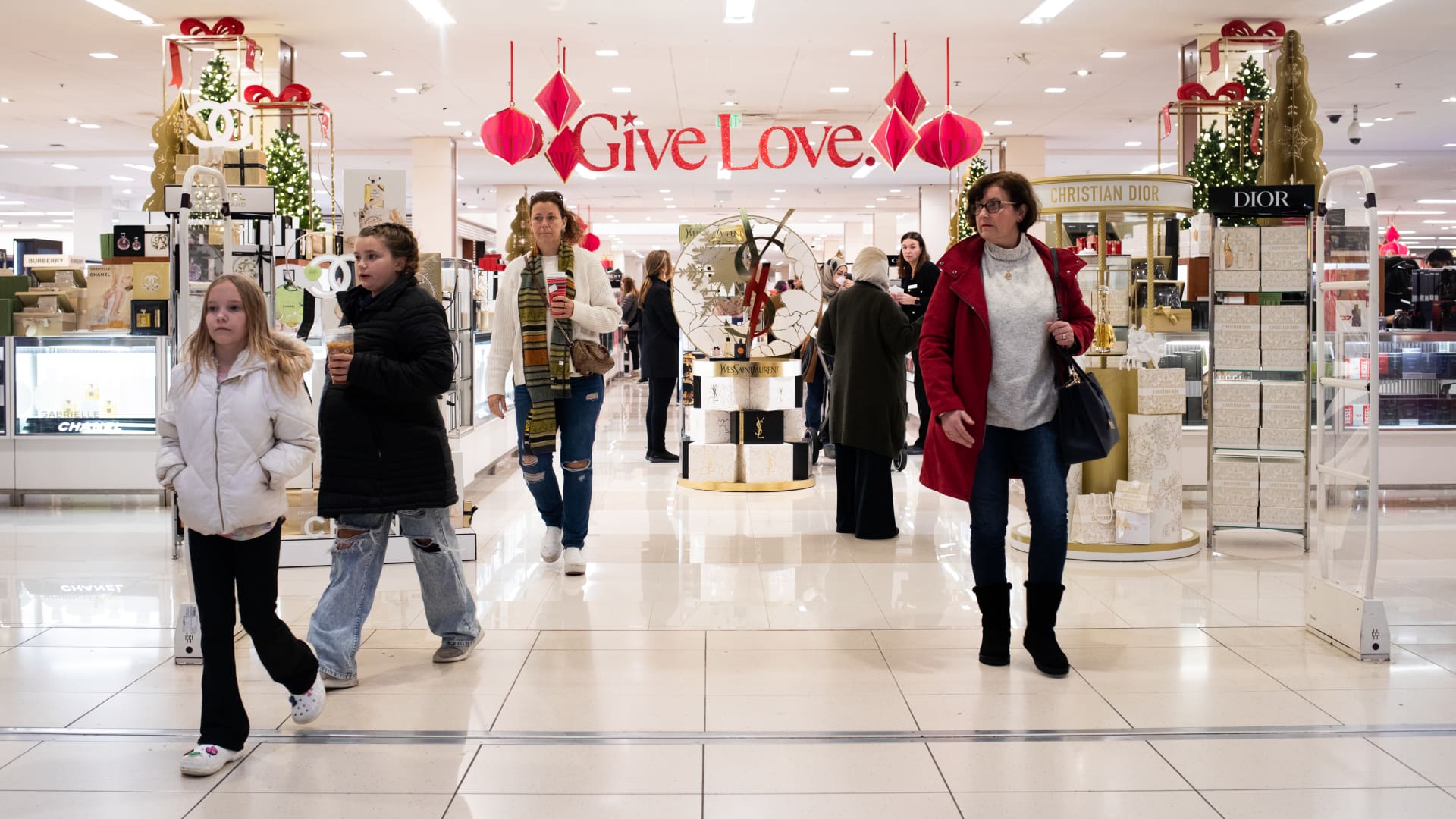Shoppers walk around Twelve Oaks Mall on November 24, 2023 in Novi, Michigan.
Emily Elconin | Getty Images
Retailers are cheering after shoppers spent big on gifts and decor in the days after they gobbled up turkey and stuffing.
But the strong showing does not necessarily mean those companies will have blowout success in their all-important holiday quarter.
Online spending shot up by nearly 8% year over year to $38 billion during the five-day period from Thanksgiving Day to Cyber Monday, according to Adobe Analytics. A record high of 200.4 million shoppers went to retailers’ stores and websites over the same period, according to a survey by the National Retail Federation. And Ulta Beauty and Foot Locker‘s shares rose this week, after the companies reported better-than-expected earnings and a strong start to holiday spending on sneakers, makeup and more.
But some unique factors may have driven those early sales, including wider adoption of online shopping, deeper discounting levels and cooler temperatures in many parts of the U.S. That’s raised questions about whether consumers’ appetite to spend will continue throughout the critical retail season — or taper off into a more pronounced lull between Black Friday and the final rush before Christmas.
Ulta is in one of the hottest categories for retail, as beauty continues to defy weaker discretionary spending trends. Yet even Ulta CEO Dave Kimbell was quick to point out this week on the company’s earnings call that retail’s biggest weeks are ahead.
He said Ulta and its beauty competitors will have higher promotional levels than a year ago, as they cater to budget-minded customers.
The NRF has tempered expectations, too, relative to recent years. The industry’s major trade group predicts 3% to 4% year-over-year growth in holiday-related spending from Nov. 1 to Dec. 31. That’s roughly in line with the average annual growth before the boom of the pandemic years.
On a call this week, NRF CEO Matt Shay said the season is on track to meet that estimate — even after shoppers blew past the trade group’s turnout expectations for the five-day Thanksgiving weekend.
Here’s a look at three key factors that contributed to Black Friday weekend:
Anastasiia Krivenok | Moment | Getty Images
Shoppers flock online
Instead of dashing to the mall after Thanksgiving dinner or lining up outside stores for doorbuster deals on Black Friday morning, more Americans are filling up shopping carts from their couches.
Online shopping still drives just a fraction of overall holiday spending, even after the cooped-up years of the pandemic — giving it plenty of room to grow. About 1 in 5 retail dollars are spent online, according to Adobe Analytics. Only about 30% of overall holiday sales last year took place online, through apps or in other locations that aren’t physical stores, according to the NRF.
Consumers spent $109.3 billion online from Nov. 1 through Cyber Monday this year, according to Adobe Analytics. That’s a 7.3% jump compared with the same period last year.
It’s an even sharper jump from pre-pandemic in 2019. Consumers spent $81.5 billion online during the stretch from Nov. 1 through Cyber Monday that year. The period this year had a few extra days since Thanksgiving was later in 2019 than in 2023, but illustrates the bigger embrace of e-commerce.
Adobe’s data covers more than 1 trillion visits to U.S. retail websites, 100 million unique items and 18 total product categories.
One reason for the shift? Some major retailers that used to draw shoppers on the evening of Thanksgiving are now shut. The closures of Walmart, Target, Best Buy and other retailers on Thanksgiving is one of the pandemic’s legacies.
Plus, in a year when Americans are more budget-minded, online can be the better way to shop, said Vivek Pandya, a lead analyst at Adobe Digital Insights. Comparing prices is easier to do by opening multiple web browsers and apps rather than driving from store to store, he said.
“The focus is on price and value and the consumer has been very strategic,” he said.
It’s too soon to say if the higher online shopping total so far this season means holiday shoppers will spend more overall year over year — or if more of their purchases are just moving to websites and apps. Adobe does not track in-store purchases, Pandya said.
Adobe predicts that full holiday season online spending from Nov. 1 to Dec. 31 will hit $221.8 billion, which would be a nearly 5% year-over-year jump. If the estimate ends up being correct, that means shoppers still have a little more than half of their online holiday spending to go.
The NRF said this week that its survey found about half of consumers’ online and in-store holiday shopping remains.
A customer visits the store during early morning Black Friday sales at Macy’s Herald Square on November 24, 2023 in New York, New York.
Kena Betancur | Getty Images
A hunger for deals
The desire for deals is an early and clear theme of the season.
After more than a year of paying higher prices for nearly everything including milk, gas and housing, U.S. shoppers have shown that a compelling price cut is one of the best motivators.
Black Friday and Cyber Monday have become synonymous with deep discounts, which may explain the outsized shopper turnout and online spending.
On Cyber Monday, for instance, consumers saw discounts peak at 31% for electronics, 27% for toys, 23% on apparel and 21% on furniture, according to Adobe.
Those price cuts in electronics, apparel and furniture were higher than Cyber Monday a year ago. Toys, on the other hand, had lower discounting levels than the last Cyber Monday.
Scott Wren, senior global market strategist at Wells Fargo, said it’s a mistake for investors to extrapolate that heightened Black Friday weekend spending means that the American consumer is healthy. Instead, he described it as the “last hurrah” before a recession that Wells Fargo predicts will take place in the first half of 2024.
He said higher credit card balances, increased costs of borrowing and the risk that the U.S. Federal Reserve may keep raising interest rates to fight inflation could spur a downturn.
“People are just about tapped out, but [with] the holiday season, people are willing to even further extend themselves,” he said.
Reality may also hit as consumers must pay off those holiday purchases.
Americans are financing purchases in new ways, along with swiping credit and debit cards. Use of buy now, pay later hit an all-time high on Cyber Monday, according to Adobe. It contributed $940 million in online spend, a nearly 43% jump year over year. Shoppers who used the payment option also put more items in their carts, as the number of items purchased rose 11% year over year.
Taking on credit card debt this holiday season will come at a steeper price, too, if consumers carry a balance from month to month because of higher interest rates.
Shoppers look at clothes during Black Friday deals at Macy’s department store at the Roosevelt Field mall in Garden City, New York, U.S., November 24, 2023.
Shannon Stapleton | Reuters
A well-timed cold snap
In many parts of the country, shoppers got away with postponing purchases of sweaters, hats, jackets and other cold-weather gear thanks to an unseasonably warm fall.
Yet Black Friday weekend brought chillier temperatures in major cities such as New York City — the kind of cold snap that retailers root for.
Over the past two months, companies including Levi Strauss and Macy’s spoke about the challenge of milder weather.
Macy’s CEO-elect Tony Spring told investors on an earnings call in mid-November that “the weather was a little warmer than we would have liked,” but stores adapted with merchandise that could transition from season to season.
Levi CEO Chip Bergh said unseasonably warm weather hurt sales of its denim at stores such as Walmart, J.C. Penney and Macy’s.
“It’s hard to sell blue jeans when it’s 110 degrees outside,” he said on a call with CNBC in October.
Colder weather over Black Friday weekend laid the groundwork for bigger sales, said Scott Bernhardt, president at Planalytics, a predictive demand and analytics company that tracks the influence of weather on retail spending. A cold snap typically motivates spending, since it puts shoppers into a holiday mood and helps their shopping list better match the seasonal merchandise that retailers have displayed in stores, he said.
Retailers may not get as lucky in the weeks ahead, Bernhardt said.














































